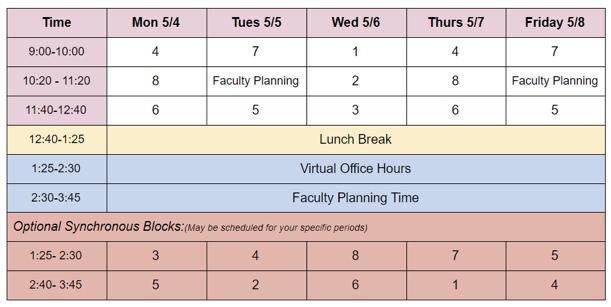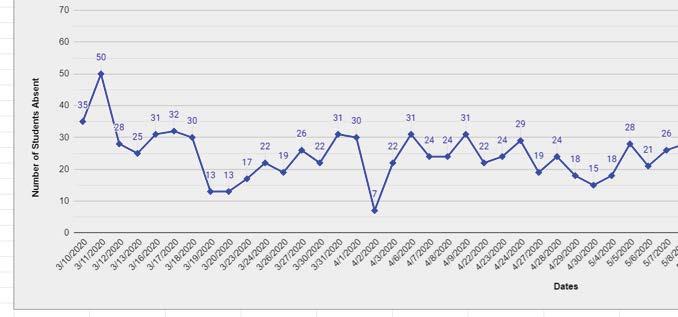
9 minute read
started again... in a different way
Flattening The Curve Of Disruption “When Everyone Else In Athens Stopped Learning, We Started Again... In A Different Way!”

first week of March 2020 in response to the COVID-19 pandemic, ACS Athens Academy students missed only one day of instruction before we reopened school online with ACS Virtual. Parents and students received an email from me that ended with what would become my tagline, “When everyone else in Athens stopped learning, we started again... in a different way!” For our students, we knew that doing things differently in the “classroom”, especially within the context of such immense disruption, would be accompanied by tremendous stress, anxiety, and even grief that might greatly affect their abilities to learn. Our job was to quickly transition to a virtual system of learning while consciously developing ways to maintain vibrant and engaged classroom communities. We knew that such an online program needed to be built upon support, trust, predictability, routine, and teaching methodologies that engage students with each other and their learning in all content areas.
At the time we did not know how long the closures would last, but we did know that the sooner we could make ACS Virtual feel “normal” for students, aka predictable, that stressors would decrease and fight or flight cortisone levels would fall, allowing students to learn more effectively. The careful planning that followed not only helped students to settle in with their learning and increase retention, but also allowed teachers to adapt and innovate learning experiences, while being as fully present as possible for their students.
Unprecedentedly, the global pandemic disrupted the world and brought a new scale of uncertainty and unpredictability to our lives. I’ve used the illustration below throughout the experience to describe that disruption from an individual school perspective. While epidemiologists devise ways to flatten the curve of viral transmission, educators think of how to “flatten” the disruptions in students’ minds so that they can focus on their learning. In the ACS Athens Academy, the virtual learning structures and learning

by David Nelson, Academy Principal
When schools closed across Greece during the
support did just that. The “new normal” has also brought new ways of thinking into our everyday lives that have so quickly become mainstream that they have even replaced the way we think about connecting, communicating, and learning with others. “Let’s zoom later.”, “...sent you a Meet invite”, “Are you interested in this webinar?”, or for ACS Athens students, “See you on BBB!”, have become so ubiquitous that few pause to wonder, and most feel at ease with such invites. What we continue to see is that as things become more predictable, students are able to focus on their learning, and teachers are even more equipped to guide them with doing so.
I recently attended a webinar conducted by the National School Reform Faculty out of Bloomington, Indiana, featuring Psychologist and author David Gleason, also a long time friend and supporter of ACS Athens. “Live in fragments no longer, only connect”,
was his theme and access point to confirm for educators the crucial role they play in students’ lives.
In his book, At What Cost?: Defending Adolescent Development in Fiercely Competitive Schools, Dr. Gleason (2017) reveals the impact of “hyperschooling” related to university admissions and other stressors that affect adolescent development. In the webinar, Dr. Gleason applies his research to examine the impacts of pivoting to an online learning environment and emphasizes the power of creating communities of connection and of establishing routines that allow for predictability and flexibility (D. Gleason PhD. & Mattoon, 2020). As he presented, so much of what he shared helped to explain the research behind the successes that so many of our students and teachers experienced with ACS Virtual.
I’d like to share a few take-aways and connections with you to describe how we pivoted so quickly into the online learning environment and what allowed so many students to focus on their learning.
1. Structures of blended learning developed through i²flex were already normal. The ACS Athens Academy has had a rich history of blending learning, which is highlighted continually in this issue of Ethos and long before (Avgerinou & Gialamas, 2016). Our faculty is well versed at designing their lessons to maximize interaction among students and between the teacher and students, not only in the classroom but also online through the Moodle platform. Independent learning is guided, both in and out of the classroom, and students are constantly encouraged to learn from each other as they analyze, design, or create.
2. Professional development with a long history of collaboration among faculty. As soon as international schools in Asia began to close in January 2020, we were already building on years of tradition with online learning and of the newly created ACS Virtual Classes that had been released in September of 2019. Not only did faculty collaborate with colleagues who had already been teaching in online classes, but they also applied ways to improve the blended learning model of i2flex to maximize interactivity and engagement, which had been our focus one year earlier. In other words, our faculty had already been digging deep into the methodologies and thinking about the possibilities. When we introduced online facilitation tools like the Big Blue Button and Google Meet, already integrated into our learning management systems, our faculty were prepared to pivot and were able to guide the students along the way. Additionally, our tech support team was on call with scheduled PD sessions, as well as constant support, to assist teachers and students as they adjusted. 3. 4. Focus on finding the optimal blend of synchronous and asynchronous learning. While many schools simply took their face-to-face schedules and replicated them online, we knew that virtual learning can not be effectively implemented by thinking the same way (Horn & Staker, 2014). We also know that the bulk of learning is not defined only by what teachers say in the classroom, but rather by the learning structures they design to maximize engagement, among their students and between their students and the curriculum content .
As an ACS Athens Principals Council, we established a schedule from the start of lockdown that sought to create a careful blend of synchronous and asynchronous learning, not full of worksheets and packets, but enriched with opportunities for students to interact through discussion forums in Moodle, group projects facilitated through Google tools, video discussions through Flipgrid, or content discussion with Voicethread, to name a few. We knew that learning is made more power-
Figure 1: ACS Athens Academy Virtual Schedule Phase I

ful with the right blend. Schedules provided consistency and flexibility for faculty. The online learning schedules that we first created began with ten hours of synchronous sessions a week, along with ten optional additional hours for faculty to meet synchronously with their students. The afternoons were dedicated to asynchronous work, through which faculty-guided students or met individually with them during the online office hours. The online schedule began at 9:00 am with two synchronous sessions and a 20-minute break to allow students time to move away from the screen. The optional sessions in the afternoon allowed teachers to schedule sync sessions according to their needs while guaranteeing students that they would not have conflicts - seemingly small proactive measures that have huge gains because there is less stress.
first three weeks of ACS Virtual, Academy teachers had offered 239 additional synchronous sessions for their students. By monitoring and adjusting our schedule, according to real needs of teachers and students based on the pacing of their curriculum, we shifted to the Phase II schedule (see Figure 1). We added an hour a day of mandatory synchronous learning, along with the maintenance of flexible time, key to specific content areas such as Math and Modern Languages. Naturally, asynchronous learning never stopped; only its scope was adjusted. The schedule that we created helped make learning more meaningful and predictable for students, also lowering their stress.
The following graph (see graph 1) represents total absences during the first weeks of ACS Athens Virtual in the Academy, an even smaller percentage of absences than normally experienced when we were face-to-face. When I informally polled parents during one of the principal’s coffees, over 50% present said that they did not need to wake their child/ren up to attend the online classes. In other words, as the data shows, the schedule and the virtual designs in the classrooms were predictable, engaging, and quickly established a routine for students.
Graph 1: ACS Athens Academy Virtual Absences March 10 - May 8, 2020 Absences are students who did not attend the scheduled synchronous sessions

Goals for learning were at a high standard with high expectations. Needless to say, at the beginning, we didn’t always get the right balance of work and challenge for all students, but teachers and administrators alike always monitored and adjusted to find the best balance. By carefully gaining feedback and analyzing formative assessments of student learning, we adjusted accordingly to find the right balance of academic rigor and care. From the beginning, we emphasized the need to focus on quality learning designs that promote student engagement and interactivity, defined as the following: tent-student, and student-student interaction in both synchronous and asynchronous learning.
Interactivity exists when students are actively engaged with other students, the teacher, or with content in an authentic learning task.
Interactivity means that students are at the center of learning, given a wide range of opportunities for inquiry and higher levels of thinking. When students are invited to ask questions about key concepts or skills and interact virtually with their peers, students drive their own understanding and seek to create deeper meaning.
6. Students’ well-being and partnerships with families were key. Perhaps the most important element of ACS Athens Virtual was the united effort to keep students and their well being at the center of focus and our first priority. Our citizenship office, counselors, and school psychologist were in constant contact with students and families to find ways to discover and support the changing needs of the students.
Teachers intentionally strove to maintain a sense of community in the virtual classrooms, and constantly reached out to students to provide support. We know that without a sense of psychological safety, students can’t learn effectively - this is our highest priority (Clark, 2020). As a school we extended the 3rd quarter to reduce the stress of arbitrary deadlines for learning and assignments, we eliminated exams that weighed heavily at 20% of a student’s grade and replaced them with quarter assessments, often performance based or project based assessments, that allowed students to apply what they learned. Finally, we met regularly with parents to learn more and communicate clearly, so that we could all be on the same page in support of our students.
There is one thing that I am certain of: I know that the experience of the past months will not be forgotten by our students, and I am confident that they will carry with them greater resilience, a stronger sense of independence, and a broader appreciation for collaboration in their learning. By helping to flatten the disruption curve for our students, I know that they have a newfound sense of time management and self-advocacy, as principled, caring, and reflective students of the world.
I thank the ACS Academy faculty and staff for making the transition possible and extend my gratitude to the parents of our community for trusting us throughout the process to find the best ways to support their stu-






